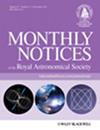利用 SALT 分析超快 BAL 外流的时间变化:基于 C iv 吸收深度的分析
IF 4.7
3区 物理与天体物理
Q1 ASTRONOMY & ASTROPHYSICS
引用次数: 0
摘要
我们对利用南部非洲大型望远镜监测到的 64 个超快外流(UFO)C iv 宽吸收线(BAL)类星体样本进行了基于吸收深度的分析,从而探究了小尺度吸收线的可变性。我们证实,随着外流速度的增加,变异性的强度也会出现强烈的单调增加。我们确定了每个源的宽吸收线槽内,在速度宽度≥500 km s-1时,两个纪元之间的归一化通量差为>0.1的区域(称为 "可变区域")。我们发现变区的总数随着探测时间间隔的增加而增加,从短(<2 年)时间尺度到长(>2 年)时间尺度,显示变区的 BALs 数量几乎增加了一倍。我们研究了变区属性的分布,如速度宽度、深度和位置。这些区域通常占整个 BAL 宽度的几十分之一。然而,无论探测的时间尺度如何,它们相对于zem的绝对速度及其在BAL剖面中的相对位置仍然是随机的。BALs的等效宽度变化与变区的大小和深度有很大关系,但与变区的总数关系不大。最后,我们发现有 17%的 UFO BALs 在 BAL 波谷内显示出不相关的变化。本文章由计算机程序翻译,如有差异,请以英文原文为准。
Time variability of ultra-fast BAL outflows using SALT: C iv absorption depth based analysis
We probe the small-scale absorption line variability using absorption depth based analysis of a sample of 64 ultra fast outflow (UFO) C iv broad absorption line (BAL) quasars monitored using the Southern African Large Telescope. We confirm the strong monotonic increase in the strength of variability with increasing outflow velocity. We identify regions inside the BAL trough for each source where the normalized flux difference between two epochs is >0.1 for a velocity width ≥500 km s−1(called ‘variable regions’). We find the total number of variable regions increases with the time interval probed and the number of BALs showing variable regions almost doubles from short (<2 yrs) to long (>2 yrs) time scales. We study the distributions of variable region properties such as its velocity width, depth, and location. These regions typically occupy a few-tenths of the entire width of the BAL. Their widths are found to increase with increasing time scales having typical widths of ∼ 2000 km s−1 for Δt > 2 yr. However, their absolute velocity with respect to zem and their relative position within the BAL profile remain random irrespective of the time scale probed. The equivalent width variations of the BALs are strongly dependent on the size and depth of the variable regions but are little dependent on their total number. Finally, we find that ∼17% of the UFO BALs show uncorrelated variability within the BAL trough.
求助全文
通过发布文献求助,成功后即可免费获取论文全文。
去求助
来源期刊

Monthly Notices of the Royal Astronomical Society
ASTRONOMY & ASTROPHYSICS-
CiteScore
9.10
自引率
37.50%
发文量
3198
审稿时长
3 months
期刊介绍:
Monthly Notices of the Royal Astronomical Society is one of the world''s leading primary research journals in astronomy and astrophysics, as well as one of the longest established. It publishes the results of original research in positional and dynamical astronomy, astrophysics, radio astronomy, cosmology, space research and the design of astronomical instruments.
 求助内容:
求助内容: 应助结果提醒方式:
应助结果提醒方式:


